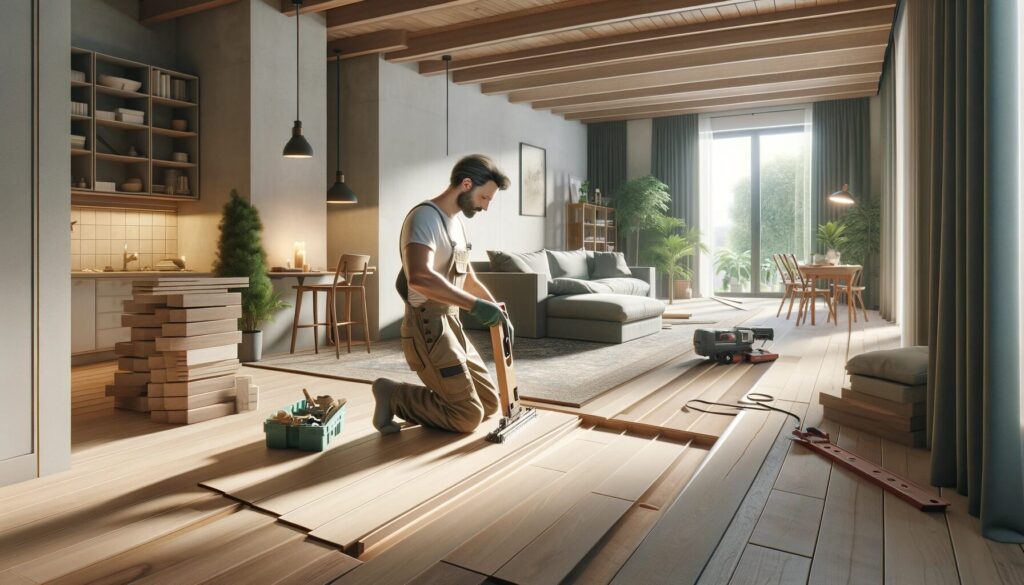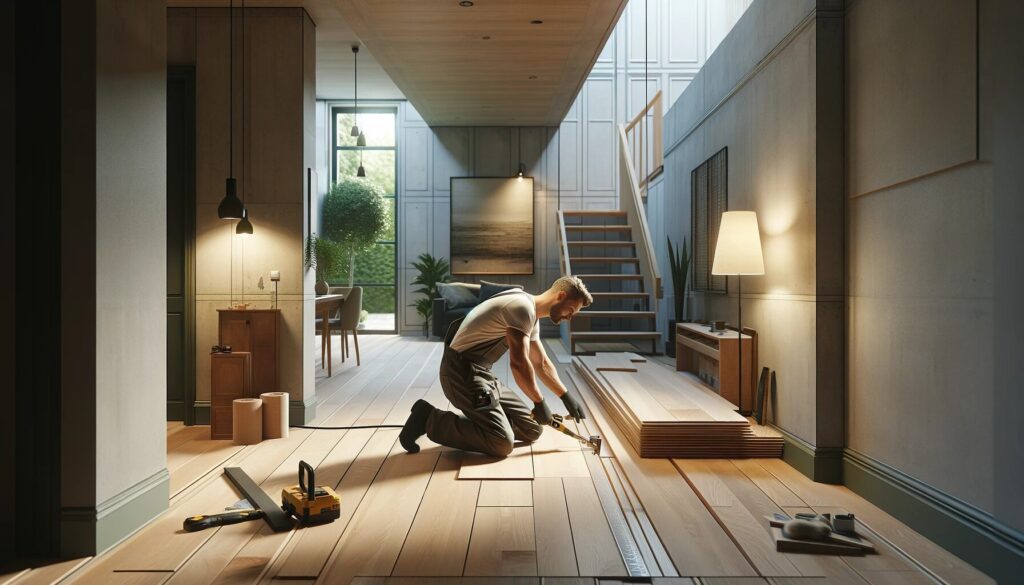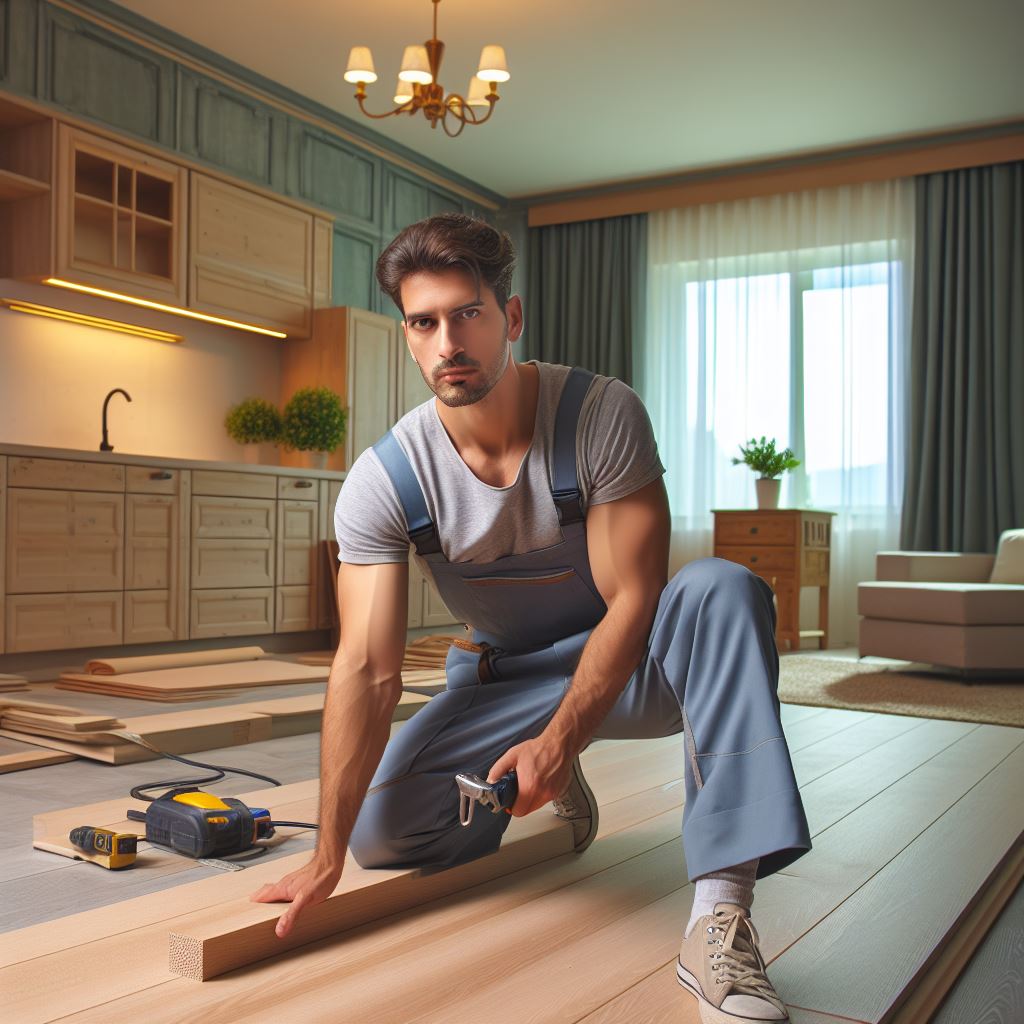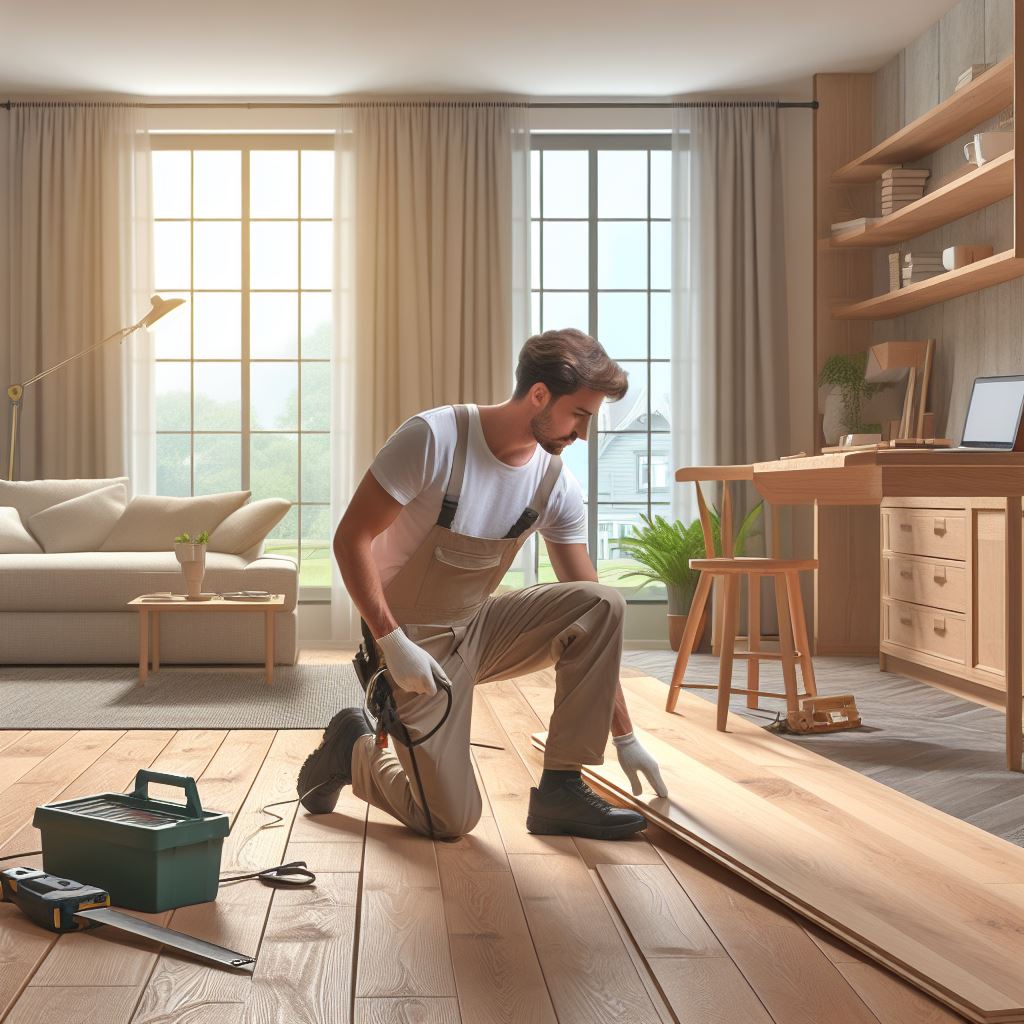When it comes to home improvement, installing hardwood floors is akin to laying down the foundation of your home’s character. This task is not just about enhancing the visual charm, it’s about investing in something that lasts and adds tangible value to your property. Whether you’re a veteran with tools in hand or a beginner aiming to elevate your living space, this guide is tailored to provide you with a detailed, step-by-step approach to hardwood floor installation.

Pre-Installation Preparation
Choosing the Right Hardwood
Selecting the right hardwood is a crucial first step. It’s about balancing aesthetics with functionality. Here’s a practical approach:
- Durability: Consider the level of foot traffic in your area. High-traffic spaces like living rooms may need tougher woods like oak, whereas bedrooms could do with softer types like pine.
- Color: Personal taste plays a big role here. Do you prefer the rich, warm hues of mahogany, or are you inclined towards the lighter tones of bamboo?
- Grain: The wood grain can dramatically affect the room’s look. Hickory offers a pronounced, varied pattern, perfect for a rustic look, whereas maple offers a subtler, more uniform pattern for a contemporary feel.
Tools and Materials Needed
Equipping yourself with the right tools is half the battle won. Here’s what you’ll need:
- Tape measure and carpenter’s square for accurate measurements and cuts.
- Chalk line to maintain straight, aligned plank rows.
- A reliable saw, like a table saw or circular saw, for cutting planks.
- A flooring nailer, preferably pneumatic, for secure and efficient installation.
- Hammer and tapping block to fit planks snugly without damaging them.
- Spacers to maintain the right expansion gap along the walls.
- Underlayment for moisture protection and soundproofing.
- Essential safety gear including goggles, gloves, and knee pads.
Room Preparation
The prep work is as important as the installation itself. Here’s what to focus on:
- Clear the Area: Ensure all furniture and existing flooring are removed.
- Clean Thoroughly: Any debris or dust can cause issues, so clean meticulously.
- Measure Accurately: Understanding your space is vital to estimate materials correctly.
- Ensure Even Subfloor: Any unevenness can be detrimental to your installation. Address these areas before proceeding.
Acclimatization of Hardwood
Hardwood floors need to adapt to their new environment before installation:
- Why Acclimatize: Wood naturally expands and contracts with environmental changes. This step is crucial to prevent future warping or gaps.
- How to Do It: Spread out the wood in the room it will be installed and let it sit for 3-5 days, maintaining normal room temperature.
- Pro Tip: Avoid extremes in temperature and humidity during this period for optimal results.

Installation Process
Subfloor Preparation
The foundation of a great hardwood floor lies in a meticulously prepared subfloor. It’s essential that the subfloor be as clean, level, and dry as possible. I’ve found that using a 6-foot level or straightedge helps in identifying any uneven areas – anything more than 3/16 inch over 10 feet is a red flag. Secure loose boards with nails to eliminate any squeaking. For concrete subfloors, moisture is a common adversary. Conduct a simple plastic sheet test to ensure there’s no moisture present. Remember, a well-prepped subfloor is the key to avoiding future headaches.
Layout Planning
Determining the layout is more art than science. Conventionally, hardwood planks are laid perpendicular to the floor joists for maximum stability. However, laying them parallel to the longest wall can visually expand the space. I recommend snapping a chalk line as a reference to keep your installation on track. The most visible wall or the main light source is typically a good starting point.
Installing the First Row
The first row sets the tone for your entire installation. Cut off the tongue side of the boards to fit neatly against the wall. Begin in a corner and use spacers to maintain an expansion gap – this small step is vital for allowing wood expansion. Hand-nail this row, countersinking the nails for a neat finish. Precision here pays dividends for the rest of the installation.
Continuing the Installation
With the first row as your guide, the rest of the installation should flow smoothly. A flooring nailer makes this process efficient and precise. Ensure that the ends of the planks in adjacent rows are staggered by at least 6 inches, similar to brickwork. This not only looks aesthetically pleasing but also adds to the floor’s structural integrity. Gently tapping each plank into place ensures a snug fit without damaging the wood.
Special Considerations
In any room, you’ll encounter unique challenges – be it a radiator, a pipe, or an irregular corner. I always advise careful measurement and the use of a jigsaw for custom cuts. Patience and precision here will result in a professional-looking finish.

Finishing Touches
Trimming and Fitting
Trimming is the final touch. Reattach baseboards and moldings over the expansion gap, ensuring not to fix them to the floor itself. For complex areas like doorways, a chisel or a Dremel can be invaluable for making precise adjustments.
Sanding (if necessary)
For unfinished wood floors, sanding is a crucial step. Begin with a coarse grit and progress to finer grits. Always sand in the direction of the grain to avoid unsightly scratches. A thorough vacuuming after each sanding stage is essential to remove all dust.
Applying Finish
The right finish can significantly enhance the durability and appearance of your hardwood floor. For high-traffic areas, polyurethane offers robust protection. Apply it using a lamb’s wool applicator or a natural bristle brush, and always follow the grain of the wood. Keeping a wet edge helps prevent lap marks. Ensure good ventilation during this process to avoid inhaling fumes.

Post-Installation
Cleaning and Maintenance Tips
After installing your hardwood floor, it’s crucial to maintain its beauty and longevity. Regular sweeping or vacuuming with a soft attachment is essential to prevent dirt and grit from scratching the surface. When mopping, use a slightly damp mop and a gentle, pH-neutral cleaner. Avoid excessive water, as it can damage wood. Every few years, consider reapplying a finish to rejuvenate the surface and address minor scratches. In high-traffic areas, area rugs can significantly reduce wear and tear.
Safety Precautions
Safety is paramount when working with construction tools and materials. Always wear appropriate personal protective equipment: safety goggles to protect your eyes, gloves to guard your hands, and ear protection when using loud equipment. Keep your workspace clean and organized to prevent accidents. A stray nail or an overlooked power cord can quickly lead to injury.
Troubleshooting and Tips
Common Challenges and Solutions
- Warped Boards: Often a symptom of moisture issues. Early detection is key, replacing affected boards is usually the best solution.
- Gaps: These can appear due to the natural expansion and contraction of wood. Controlling indoor humidity can help, as can using a humidifier during dry months.
- Squeaky Boards: This can indicate movement between the boards and the subfloor. Sometimes, securing the board with a nail or screw can solve the problem.
Pro Tips
- Efficiency in Cutting: Set up a dedicated cutting station near your work area to save time and maintain focus.
- Achieving Improved Results: Plan several rows ahead in your layout to avoid repeating patterns and ensure proper staggering of seams for both aesthetic and structural integrity.
FAQ Section
Generally, 3-5 days. This period allows the wood to adjust to the room’s climate, which is critical to prevent future warping or gapping.
Yes, but with conditions. The existing floor must be flat and stable. Consideration should be given to door heights and room transitions.
Use a power miter saw for crosscuts and a table saw for rip cuts. Sharp blades are crucial for clean, precise cuts.
Conduct moisture tests on the subfloor before installation. In the case of concrete subfloors, a moisture barrier is essential. Maintain consistent indoor humidity levels.
Yes. Expansion gaps are vital to accommodate natural wood movement and are typically concealed under the baseboards.
